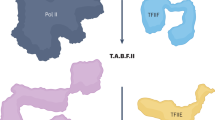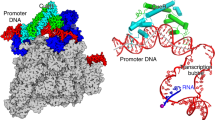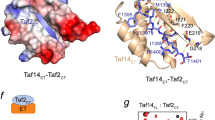Abstract
The carboxy-terminal domain (CTD) of the largest subunit of RNA polymerase II becomes multiply phosphorylated by protein kinases during early steps in the gene transcription cycle both in vivo1 and in vitro2. In yeast, the major CTD kinase is a subunit of the general transcription factor TFIIH, and is encoded by an essential gene, KIN28 (ref. 3). Although the CTD and its phosphorylation are important for transcription4,5,6, in vitro studies7,8 have challenged whether CTD phosphorylation is an absolutely required step. The general importance of CTD phosphorylation by Kin28 for transcription in yeast has been suggested because, for all genes tested, transcription is inhibited at the non-permissive temperature in temperature-sensitive kin28 mutants9,10. However, using such a mutant and a copper-inducible targeted destruction method, we show here that transcription of certain genes can be highly induced even when cells lack Kin28. We also show that transcription of these Kin28-independent genes is independent of Srb4 and Srb6, critical components of the CTD-associated transcriptional mediator complex11. These results indicate that there are at least two distinct pathways for transcriptional activation: one is dependent on Kin28 and the mediator complex, and the other is not.
This is a preview of subscription content, access via your institution
Access options
Subscribe to this journal
Receive 51 print issues and online access
$199.00 per year
only $3.90 per issue
Buy this article
- Purchase on Springer Link
- Instant access to full article PDF
Prices may be subject to local taxes which are calculated during checkout



Similar content being viewed by others
References
O'Brien, T., Hardin, S., Greenleaf, A. & Lis, J. T. Phosphorylation of RNA polymerase II C-terminal domain and transcriptional elongation. Nature 370, 75–77 (1994).
Laybourn, P. J. & Dahmus, M. E. Phosphorylation of RNA polymerase IIA occurs subsequent to interaction with the promoter and before the initiation of transcription. J. Biol. Chem. 265, 13165–13173 (1990).
Feaver, W. J., Svejstrup, J. Q., Henry, N. L. & Kornberg, R. D. Relationship of CDK-activating kinase and RNA polymerase II CTD kinase TFIIH/TFIIK. Cell 79, 1103–1109 (1994).
Scafe, C. et al. RNA polymerase II C-terminal repeat influences response to transcriptional enhancer signals. Nature 347, 491–494 (1990).
Gerber, H.-P. et al. RNA polymerase II C-terminal domain required for enhancer-driven transcription. Nature 374, 660–662 (1995).
Akoulitchev, S., Makela, T. P., Weinberg, R. A. & Reinberg, D. Requirements for TFIIH kinase activity in transcription by RNA polymerase II. Nature 377, 557–560 (1995).
Serizawa, H., Conaway, J. W. & Conaway, R. C. Phosphorylation of C-terminal domain of RNA polymerase II is not required in basal transcription. Nature 363, 371–374 (1993).
Makela, T. P. et al. Akinase-deficient transcription factor TFIIH is functional in basal and activated transcription. Proc. Natl Acad. Sci. USA 92, 5174–5178 (1995).
Cismowski, M. J., Laff, G. M., Solomon, M. J. & Reed, S. I. KIN28 encodes a C-terminal domain kinase that controls mRNA transcription in Saccharomyces cerevisiae but lacks cyclin-dependent kinase-activating kinase (CAK) activity. Mol. Cell. Biol. 15, 2983–2992 (1995).
Valay, J.-G. et al. The KIN28 gene is required both for RNA polymerase II mediated transcription and phosphorylation of the Rpb1p CTD. J. Mol. Biol. 249, 535–544 (1995).
Thompson, C. M. & Young, R. A. General requirement for RNA polymerase II holoenzymes in vivo. Proc. Natl Acad. Sci. USA 92, 4587–4590 (1995).
Thiele, D. J. ACE1 regulates expression of the Saccharomyces cerevisiae metallothionein gene. Mol. Cell. Biol. 8, 2745–2752 (1988).
Qiu, H. et al. The Saccharomyces cerevisiae DNA repair gene RAD25 is required for transcription by RNA polymerase II. Genes Dev. 7, 2161–2171 (1993).
Giardina, C. & Lis, J. T. Dynamic protein-DNA architecture of a yeast heat shock promoter. Mol. Cell. Biol. 15, 2737–2744 (1995).
Boorstein, W. R. & Craig, E. A. Structure and regulation of the SSA4 HSP70 gene of Saccharomyces cerevisiae. J. Biol. Chem. 265, 18912–18921 (1990).
Moqtaderi, Z. et al. TBP-associated factors are not generally required for transcriptional activation in yeast. Nature 383, 188–191 (1996).
Dubois, M.-F. et al. Heat-shock inactivation of the TFIIH-associated kinase and change in the phosphorylation sites of the C-terminal domain of RNA polymerase II. Nucleic Acids Res. 25, 694–700 (1997).
Lee, J. M. & Greenleaf, A. L. CTD kinase large subunit is encoded by CTK1, a gene required for normal growth of Saccharomyces cerevisiae. Gene Expr. 1, 149–167 (1991).
Liao, S.-M. et al. Akinase-cyclin pair in the RNA polymerase II holoenzyme. Nature 374, 193–196 (1995).
Barberis, A. et al. Contact with a component of the polymerase II holoenzyme suffices for gene activation. Cell 81, 359–368 (1995).
1. Ptashne, M. & Gann, A. Transcriptional activation by recruitment. Nature 386, 569–577 (1997).
Hengartner, C. J. et al. Association of an activator with an RNA polymerase II holoenzyme. Genes Dev. 9, 897–910 (1995).
Gonzalez-Couto, E., Klages, N. & Strubin, M. Synergistic and promoter-selective activation of transcription by recruitment of transcription factors TFIID and TFIIB. Proc. Natl Acad. Sci. USA 94, 8036–8041 (1997).
Thompson, C. M., Koleske, A. J., Chao, D. M. & Young, R. A. Amultisubunit complex associated with the RNA polymerase II CTD and TATA-binding protein in yeaast. Cell 73, 1361–1375 (1993).
Kim, Y.-J. et al. Amultiprotein mediator of transcriptional activation and its interaction with the C-terminal repeat domain of RNA polymerase II. Cell 77, 599–608 (1994).
Svejstrup, J. Q. et al. Evidence for a mediator cycle at the initiation of transcription. Proc. Natl Acad. Sci. USA 94, 6075–6078 (1997).
Rougvie, A. E. & Lis, J. T. The RNA polymerase II molecule at the 5′ end of the uninduced hsp70 gene of D. melanogaster is transcriptionally engaged. Cell 54, 795–804 (1988).
Hansen, S. K. et al. Transcription properties of a cell type-specific TATA-binding protein, TRF. Cell 91, 71–83 (1997).
Shen, W.-C. & Green, M. R. Yeast TAFII145 functions as a core promoter selectivity factor, not a general coactivator. Cell 90, 615–624 (1997).
Elion, E. A. & Warner, J. R. An RNA polymerase I enhancer in Saccharomyces cerevisiae. Mol. Cell. Biol. 6, 2089–2097 (1986).
Acknowledgements
We thank A. Bensaude, G. Faye, M. Cismowski, S. Reed, A. Greenleaf, S. Prakash and R. Young for strains; M. Cismowski for pSF-KIN28 plasmid; Z. Moqtaderi and K. Struhl for strains and plasmids used for generating copper knockout strains; S. Walker and M. Green for sequences of S1 probes; D. Thiele for advice on CUP1 induction; C. Wang for generating the Kin28 copper knockout strain; J.Roberts and E. Alani for critically reading the manuscript; and members of the Lis lab for criticism and encouragement. This work was supported by an NIH grant to J.T.L.
Author information
Authors and Affiliations
Corresponding author
Rights and permissions
About this article
Cite this article
Lee, Dk., Lis, J. Transcriptional activation independent of TFIIH kinase and the RNA polymerase II mediator in vivo. Nature 393, 389–392 (1998). https://doi.org/10.1038/30770
Received:
Accepted:
Issue Date:
DOI: https://doi.org/10.1038/30770
This article is cited by
-
Inducible and constitutive heat shock gene expression responds to modification of Hsp70 copy number in Drosophila melanogaster but does not compensate for loss of thermotolerance in Hsp70null flies
BMC Biology (2008)
-
Promoter activation when the ChIPs are down
Nature Structural & Molecular Biology (2006)
-
Activator-specific recruitment of Mediator in vivo
Nature Structural & Molecular Biology (2006)
-
RNA polymerase II elongation through chromatin
Nature (2000)
Comments
By submitting a comment you agree to abide by our Terms and Community Guidelines. If you find something abusive or that does not comply with our terms or guidelines please flag it as inappropriate.



